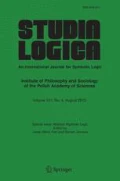Abstract
Aim of the paper is to present a new logic of technical malfunction. The need for this logic is motivated by a simple-sounding philosophical question: Is a malfunctioning corkscrew, which fails to uncork bottles, nonetheless a corkscrew? Or in general terms, is a malfunctioning F, which fails to do what Fs do, nonetheless an F? We argue that ‘malfunctioning’ denotes the modifier Malfunctioning rather than a property, and that the answer depends on whether Malfunctioning is subsective or privative. If subsective, a malfunctioning F is an F; if privative, a malfunctioning F is not an F. An intensional logic is required to raise and answer the question, because modifiers operate directly on properties and not on sets or individuals. This new logic provides the formal tools to reason about technical malfunction by means of a logical analysis of the sentence “a is a malfunctioning F”.
Similar content being viewed by others
References
Bolinger D.: Adjectives in English: attribution and predication. Lingua 18, 1–34 (1967)
Carrara M., Vermaas P.: The fine-grained metaphysics of artefactual and biological functional kinds. Synthese 169, 125–143 (2009)
Carrara, M. and B. Jespersen (ms.), Double privation, in submission.
Clark R.: Concerning the logic of predicate modifiers. Noûs 4, 311–335 (1970)
Cummins R.: Functional analysis. Journal of Philosophy 72, 741–765 (1975)
Davies P. S.: The nature of natural norms: why selected functions are systemic capacity functions. Noûs 34, 85–107 (2000)
Dipert R.R.: Artifacts, Art Works, and Agency. Temple University Press, Philadelphia (1993)
Duži, M. and B. Jespersen (ms. 1), Transparent quantification into hyperpropositional contexts de re, Logique et Analyse, forthcoming.
Duži, M. and B. Jespersen (ms. 2), Transparent quantification into hyperpropositional contexts de dicto, in submission.
Fine K.: Essence and modality. Philosophical Perspectives 8, 1–16 (1994)
Franssen, M. and B. Jespersen, From nut-cracking to assisted driving: stratified instrumental systems and the modeling of complexity, in R. Robins (ed.), Engineering Systems: Achievements and Challenges, MIT Press, Cambridge, MA, 2009, pp. 1–11.
Griffiths P.E.: Functional analysis and proper functions. British Journal for the Philosophy of Science 44, 409–422 (1993)
Heim I., Kratzer A.: Semantics in Generative Grammar. Blackwell, Oxford (1998)
Jespersen B.: Explicit intensionalization, anti-actualism, and why Smith’s murderer might not have murdered Smith. Dialectica 59, 285–314 (2005)
Jespersen B.: Predication and extensionalization. Journal of Philosophical Logic 37, 479–499 (2008)
Jespersen, B., From (AB)a infer A * a, in M. Peliš (ed.), The Logica Yearbook 2009, College Publications, London, 2010, pp. 97–108.
Jespersen B.: How hyper are hyperpropositions?. Language and Linguistics Compass 4, 96–106 (2010a)
Jespersen, B., Hyperintensions and procedural isomorphism: Alternative (1/2), in T. Czarnecki, K. Kijania-Placek, O. Poller, and J. Woleński (eds.), The Analytical Way. Proceedings of the 6th European Congress of Analytic Philosophy, College Publications, London, 2010b, pp. 299–320.
Jespersen, B. (ms.1) Left subsectivity, in submission.
Jespersen, B., Recent work on structured meaning and propositional unity, Philosophy Compass, forthcoming.
Jespersen B., Carrara M.: Two conceptions of technical malfunction. Theoria 77, 117–138 (2011)
Jespersen B., Materna P.: Are wooden tables necessarily wooden?. Acta Analytica 17, 115–150 (2002)
Jespersen, B., and G. Primiero (ms.), Lecture Notes in Computer Science, forthcoming
Kamp, H., Two theories about adjectives, in E. L. Keenan (ed.), Formal Semantics of Natural Language, Cambridge University Press, Cambridge, 1975, pp. 123–155.
Kamp H., Partee B.: Prototype theory and compositionality. Cognition 57, 129–191 (1995)
Kroes, P., Technical Artefacts: Creations of Mind and Matter, Springer, forthcoming.
Millikan R.: Wings, spoons, pills and quills: a pluralist theory of function. Journal of Philosophy 96, 192–206 (1999)
McLaughlin P.: What Functions Explain: Functional Explanation and Self-Reproducing Systems. Cambridge University Press, Cambridge (2001)
Montague, R., English as a formal language, in B. Visentini et al. (eds.), Linguaggi nella societá e nella tecnica, Milan, 1970, pp. 189–224. Reprinted in: R. H. Thomasson (ed.), Formal Philosophy, Yale University Press, New Haven, London, 1974.
Muskens, R., Meaning and Partiality, CSLI and FOLLI, Stanford, 1995.
Muskens R.: Sense and the computation of reference. Linguistics and Philosophy 28, 473–504 (2005)
Neander K.: Functions as selected effects: the conceptual analyst’s defense. Philosophy of Science 58, 168–184 (1991)
Partee, B., Privative adjectives: subsective plus coercion, in R. Bäuerle, U. Reyle, and T. E. Zimmermann (eds.), Presupposition and Discourse, Elsevier, Amsterdam, 2001.
Preston B.: Why is a wing like a spoon? A pluralist theory of function. Journal of Philosophy 95, 215–254 (1998)
Primiero G., Jespersen B.: Two kinds of procedural semantics for privative modification. Lecture Notes in Artificial Intelligence 6284, 252–271 (2010)
Sloman S.A., Malt B.C.: Artifacts are not ascribed essences, nor are they treated as belonging to kinds. Language and Cognitive Processes 18, 563–582 (2003)
Tichý, P., Smysl a procedura, Filosofický časopis 16:222–232, 1968. Reprinted as Sense and Procedure, [44], pp. 79–92.
Tichý, P., Intension in terms of Turing machines, Studia Logica 26:7–25, 1969. Reprinted in [44], pp. 95–109.
Tichý, P., An approach to intensional analysis, Noûs 5:273–297, 1971. Reprinted in [44], pp. 113–137.
Tichý, P., Two kinds of intensional logic, Epistemologia 1:143–164, 1978. Reprinted in [44], pp. 307–364.
Tichý, P., Existence and God, Journal of Philosophy 76:403–420, 1979. Reprinted in [44], pp. 355–372.
Tichý, P., Indiscernibility of identicals, Studia Logica 45:251–273, 1986. Reprinted in [44], pp. 649–671.
Tichý P.: The Foundations of Frege’s Logic. DeGruyter, Berlin (1988)
Tichý, P., in V. Svoboda, B. Jespersen, and C. Cheyne (eds.), Collected Papers in Logic and Philosophy, Filosofia, Czech Academy of Science/University of Otago Press, Prague/Dunedin, 2004.
Wiggins D.: Sameness and Substance Renewed. Cambridge University Press, Cambridge (2001)
Author information
Authors and Affiliations
Corresponding author
Rights and permissions
About this article
Cite this article
Jespersen, B., Carrara, M. A New Logic of Technical Malfunction. Stud Logica 101, 547–581 (2013). https://doi.org/10.1007/s11225-012-9397-8
Received:
Published:
Issue Date:
DOI: https://doi.org/10.1007/s11225-012-9397-8




